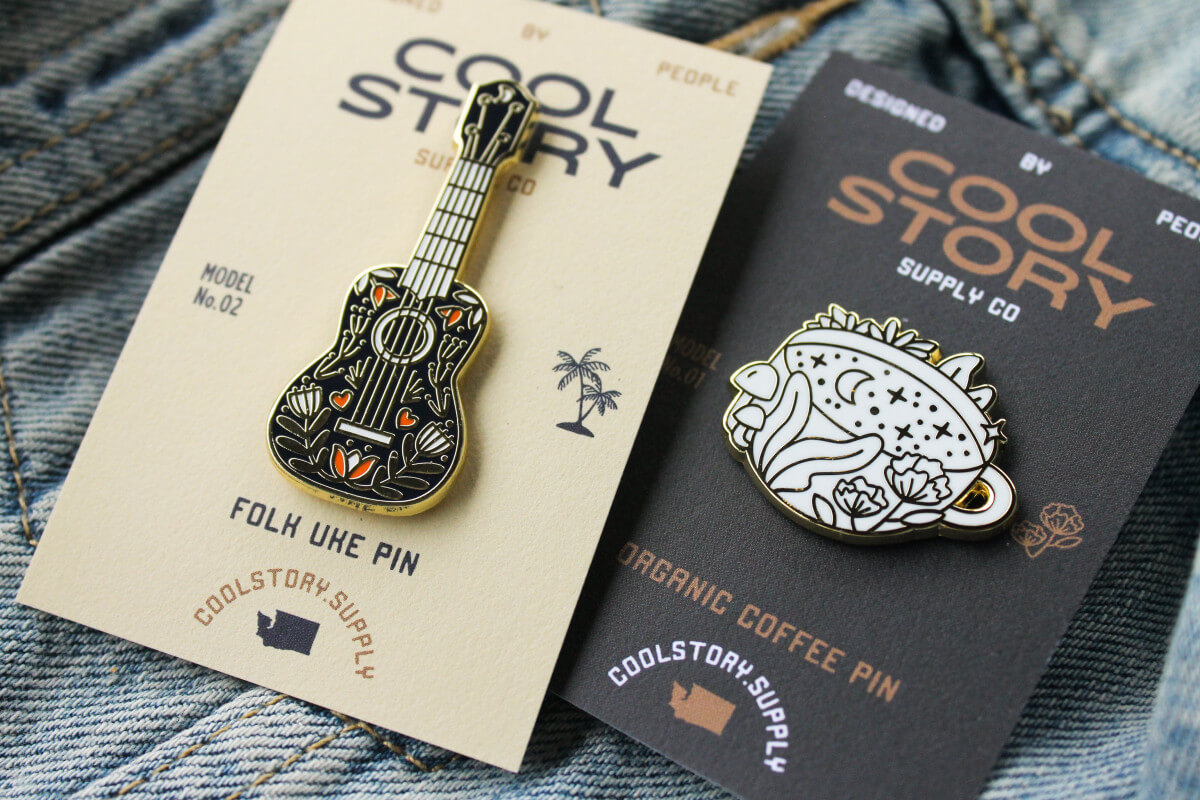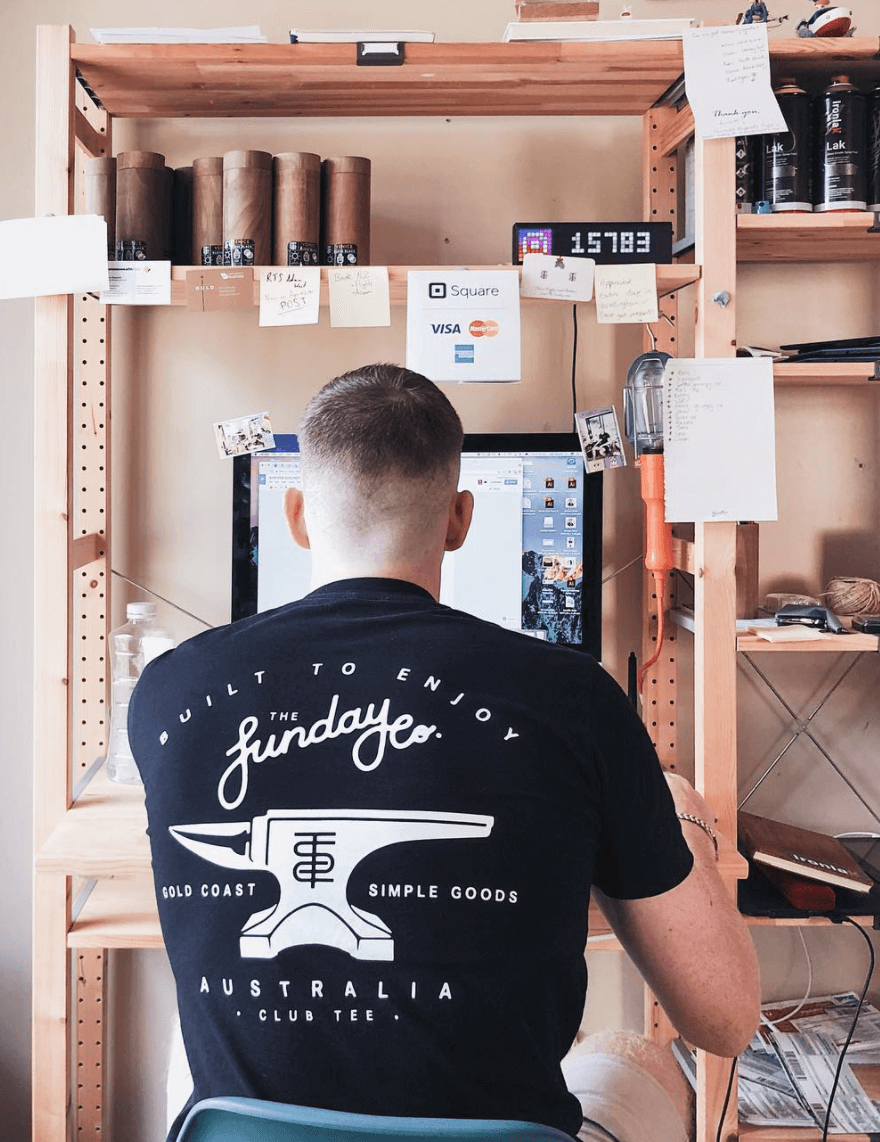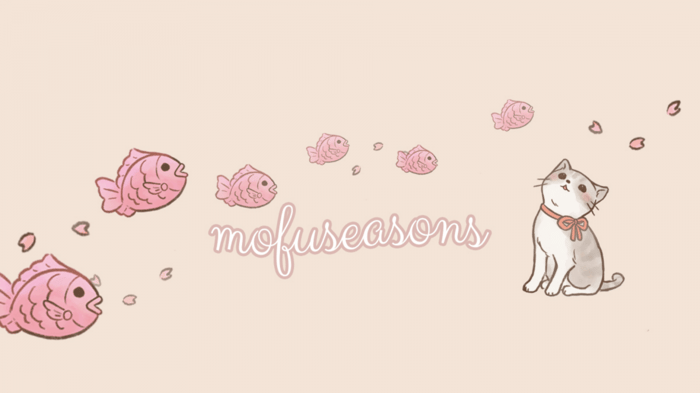Every artist we have spoken to has been faced with the hard question of "how do you turn a hobby into something you can do full-time by selling online?". Whether you're just starting the exciting journey or struggling to juggle two roles, we hope this blog solves some of the questions you have about how to start selling your products online before it becomes too much to handle.
"Sadly... most artists get discouraged before they see success!"
To begin, you're most likely reading this as you have decided to take the challenge of starting a product business and want to sell online, however like so many, you may have a real fear of your passion failing or finding it too hard to grow past the point of only enough sales to support your coffee habit. This blog exists only to show you that replacing your 9-5 job (which you may not be loving as much anymore) and going full-time with your passion is very possible and worth it with the right strategy in place. Yourstuffmade is one of those success stories, which only became possible with the amazing artist team who individually took their creative passions and turned them into successful full-time brands!
Our success came with a lot of learning and honestly many stressful breakdowns along the way, the road is not always easy but some things are worth the stress and hard work, right? Before starting this tough journey, (not trying to discourage you at all) it is important to be honest with yourself as rewards from sales will not always help you keep going, our team found the key to going full-time is making sure you find your passion before starting. Our guide below is to help with the avoidable mistakes and stress so many creators encounter starting to sell online and to give back to a community that helped us. Yourstuffmade was built off our excitement to see as many talented creators share their work and to live their passions full-time! :)

So let's get to work, you have come up with an amazing product idea, found us to help manufacture your ideas into products and now you need to know how to find customers to keep you creating and growing your passion, now what?
Here is a breakdown of the most important tips to successfully sell your products online and to learn how to sell offline, simply visit our "How to start selling products offline" blog. (coming soon)
SELLING ONLINE
Selling online is an easy choice to get started. It is low cost, has the largest audience (with global reach) to find your niche, and does not require a lot of effort to start. The attraction of selling online has meant many are thinking the same way, making it extremely competitive and difficult to stand out. Another big challenge creators find is that you can't connect with your customers as well as you would be able to do offline or may be difficult to sell your products if they need testing such as clothing.
The two main methods to sell online are through a marketplace website or a private website.
Popular marketplace websites include (click the links to find out more)
Popular private website platforms include (click the links to find out more)
The big question asked is should you pick a marketplace website or create a private website? Here are a few key areas to compare to see the right fit for your idea.
Sales: Marketplaces win here for ease of use to get sales fast since they already have customers that may fit with what you are looking for (for example Etsy is great for selling hand-made, design products). Private websites take more work but the big reward is you own your customer's information, meaning you can use this for marketing and creating amazing customer service, usually meaning you have a much better conversion rate (people viewing your product and if they decide to buy).
Cost: Both charge differently, marketplace websites make most of their money from a fee from each sale you make on their platform (these can really add up, but most often you don't notice these charges as you celebrate getting an order). In comparison, private websites make most of their money charging a monthly subscription fee depending on the plan you need. Many creators say that a subscription fee can really add stress when just starting off and don't have any sales yet, so it is something you need to invest in. Private website has a free trial period long enough to see if it works for you and it to build the website you want before being charged (usually 14-30 days)
Getting started: Marketplace websites are very easy since you're only really signing up and posting your products for sale, very simple! Understandably private websites take longer to get started because you can do and will want to create more, although it is much easier than you might think. Choosing Shopify for instance you will need to know little to no computer code to make it stand out.
Still can't decide? Luckily you don't have to pick one! A secret is most artists sell on both marketplace websites and have a private website to take advantage of each.
Our clear winners (drum roll), voted by our team are using Shopify & Etsy!
Why? Etsy is great for small shops and artists creating unique products and Shopify is amazingly simple to use and has the best app store by far to help you add great tools to your website. Below is a list of the team's favorite apps (they may be different for each country)
- Customer support: Gorgias - helpdesk
- Shipping rates: Easyship
- Reviews: Loox
- Blogs: DropInBlog
- Accounting: Xero
- Email marketing: Klaviyo
- Loyalty: Smile.io
- Buy now/pay later: Afterpay
Here are a few tutorial videos we found most helpful for each:
HELPFUL HINTS TO GET STARTED
Everyone in our team has invested in planning before selling online. Although we all had different styles to journal and plan (find what works for you) we noticed our areas of planning had a lot in common. Below is a list of areas worth researching.
Setting a price: You may have heard 'value is subjective' and yes it is as your designs, brand culture, packaging, delivery, marketing, service, photography, etc. all help to improve your price. It is always important to add value to your products and brand! But sadly most customers won't decide that way (may not have enough time, budget, etc). To make it easier for customers to buy, research the prices that similar products are selling for and set your prices within that $ range (you can change your prices after you decide, just try not to change too often to help your fans budget).
Crowdfunding: Crowdfunding platforms have become an increasingly popular way for creators to get started on a budget by offering a way to pre-sell products before making a larger order (which you may not have funds for yet) while also offering a great way to market and build interest in new products. Crowdfunding is used by both new and existing creators to help lower risk or create excitement before launching. The most popular platforms used are Kickstarter and Indiegogo, there is a lot to understand about crowdfunding, if this way seems interesting, we found this great online tutorial to help your research.
Product photos: You have spent hours/days/weeks designing an amazing product and waited patiently for it to arrive only to find you can't make them look desirable at all! :(
You are now stuck with two options, hiring a photographer (trying to get friend rates to keep the costs down) or learning yourself. Learning can be really fun and the good news is you don't need the most expensive equipment to create amazing content. An early lesson you will find is each product seems to have a different style to look great. An example is a reflective surface like an enamel pin or jewelry that needs really good lighting or an angle to look best. Check out similar brands for inspiration or book a creator chat with us to ask for help and share your ideas.
MARKETING AND PROMOTIONS
Once you have created a way for people to buy your product online, the next step would be to plan how people can find them, and fall in love and buy your products. A lot of the focus for marketing online is through social media platforms. The most popular being Facebook, Instagram and LinkedIn or anywhere your target customers like to spend their time. Below are a few ways you can use to market online:
Product giveaways/contests: Everyone loves FREE stuff! This may at first seem opposite to making more sales or money to grow your shop, but it really attracts people who may be interested. An important rule to not make a giveaway a waste is to ask people for a favor to enter, common requests are to follow your social pages, fill in a survey, share your content with others, or even make an order, be as creative as possible to match your brand and make it a fun experience for everyone.
Collaboration: Collaborations can be difficult to step up since a partnership is built on sharing a common goal and trust. When done right, collaborations can be a very fun way of joining two or more great ideas, people, brands, or designs together. Think about how many songs have multiple artists or when companies like Nike join forces with people like Micheal Jordan, this can be very powerful!
Cross-promotion: Similar to collaboration but instead of promoting one product you are promoting two products or services that don't compete with each other to join power in increasing interest in your products.
Sales and offers: Everyone loves a great bargain when something goes on sale, but many brands are now moving away from discounts as this can make it hard to sell your products at full price if you do sales too often. Offers are a popular way to keep your shop looking premium. Popular offers used by shops are free shipping, up-selling (the more you buy, the more you save), package deals (offering products together at a package price, less than ordering separately) or a free gift (spend over this amount and get a free sticker with your order). The aim for sales and offers is to help you sell more and get more profit from each order while also making it more interesting to order from you.
Getting featured by reposters/influencers: There are hundreds of new brands being built every day so standing out can be really hard! Reposters and influencers create curated accounts that make money from sharing your work to promote to their community, trying to promote "only the best" content that their community. Since reposters and influencers aren't often selling themselves, they can share a lot of other content to focus on keeping their community interested. These pages can make money by charging a fee to share and promote other content. Fees can be very different, usually decided by the amount of followers (the number of people that could potentially see the content) and what you may be asking them to do for you.
An affordable way to start testing is to ask if a reposter or influencer if they would be open to post for free product or if you gave them a discount code (this helps them reward their community to keep interest). Be creative and start with smaller reposters and influencers which may be more flexible.
Warning! Not all product reposters and influencers are good... remember "don't judge a book by its cover" a large following doesn't mean a larger influence, unfortunately faking followers is very real. Do your research, try to imagine who would like their content (are your customers similar?), research their page activity (comments, likes, etc) and send off any questions before deciding to work with anyone.
Some of the largest accessory communities to check are:

Join communities: Communities offer much more than a great place to meet people who may like to buy your products, they can offer ways to trade, socialize and most importantly learn from like-minded people (made so many strong friendships in communities). Joining can be a bit scary if you feel you are "too new" and don't have any information yet to share, but you will fast learn that there are many like you, just as nervous! :) I have never met a community that has made me feel unwelcome. If you design and create enamel pins try joining Pin Nation and Pin & Art Collector Marketplace.
Now that you have created a way to order your products online and a way to find your shop, it is now time to keep building momentum. ("the grind")
Building momentum and keeping your brand standing out is honestly one of the most important skills in turning your passion into something you can do full-time. Many artists we speak to fall into the trap of starting too slow and not investing enough into bringing out new designs and products, or going too hard and posting everything they have then going quiet.
"No one wants to be a one 'product' hit wonder"
A common start-up story is starting a website and social following with a product or two, to only find in a week's time, with the same amount of effort your sales seem to be dropping to almost nothing. After re-posting the same content to keep up sales your audience just seems to stop paying attention to you... What is happening? the fact is people get bored and distracted easily so they need a reason to re-visit your website again.
How do you solve this annoying problem? Release something new as often as you can!
- new products and designs (a simple cost saver is to produce different versions (colors/limited edition) of the same design, manufacturers like us don't charge anything more for this and it can really help interest)
- blogs and content (your brand should not just be about selling products, keep peoples interest through writing relevant articles and posting exciting content such as design videos)
We understand it is hard when you are starting out to make your store look interesting, especially on a tight budget. A lot of artists for this reason delay a launch until they have many designs to post. Larger order helps production costs and running your shop become far more relaxing when you already have something planned to release to keep people's interest. Larger brands do this by planning most product launches even years in advance, which helps them seem stable and helps marketing keep people interested. If only we had that luxury!
A rule our team follows is when you create an order, already start designing your next products and order by the time your first order arrives. Releasing new products won't just help the new sell, it will also help sell the older designs, another benefit is the more designs you have in your shop, the easier it is to create fun offers.
Keeping people's interest is vital to find out what works and to grow your brand, planning in advance and having a schedule will save a lot of stress when it comes to starting to sell online. Building momentum means investing in your shop often so it can grow until it grows to a point that it becomes your life!
FINAL INSPIRATION
We would love your products and designs to make someone smile! :) The journey of starting your own shop is not free from challenges, failure, and costs. For our team members, it was honestly the best life experience (little to no regrets) and something we all became addicted after realizing the dream of going full-time with our passion. Yourstuffmade wouldn't have been possible without everyone taking a risk to create products.
In conclusion. You can't avoid every challenge in life, so have fun, do your research, ask us for help, believe in yourself, remember why you started your journey often, test new ideas, dream big and enjoy the ride while connecting with a community that embraces your joy :)

Thank you so much for taking the time to read this, we are so excited to work with you! Make sure to share it with other amazing creators and read our other blogs to help :)
Do you have more questions? Contact our team!
Instagram > Facebook > Website > Email > Book a chat





